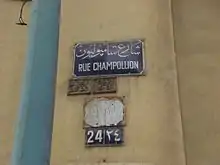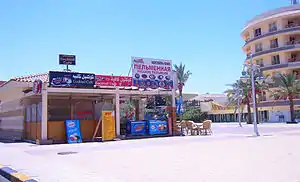Languages of Egypt
Egyptians speak a continuum of dialects. The predominant dialect in Egypt is Egyptian Colloquial Arabic or Masri/Masry (مصرى Egyptian), which is the vernacular language.[6] Literary Arabic is the official language[7] and the most widely written; additionally, it is the liturgical language of Islam, the majority religion and state religion of Egypt. The Coptic language is used primarily by Egyptian Copts and it is the liturgical language of Coptic Christianity.
| Languages of Egypt | |
|---|---|
| Official | Literary Arabic |
| Vernacular | Egyptian Arabic (68%) (de facto lingua franca) |
| Minority | Sa'idi Arabic (29%) Bedouin Arabic (1.6%) Sudanese Arabic (0.6%) Domari (0.3%) Nobiin (0.3%) Beja (0.1%) Siwi Coptic (for Coptic Christian rituals and spoken, colloquially, by some Copts[1]) |
| Immigrant | Greek Armenian Italian |
| Foreign | English French Spanish |
| Signed | Egyptian Sign Language |
| Historical language(s) | Ancient Egyptian Meroitic [2][3][4][5] |
| This article is part of a series on |
| Life in Egypt |
|---|
 |
| Culture |
| Society |
|
| Politics |
| Economy |
|
Egypt portal |
Main spoken language
Egyptian Arabic is the commonly spoken language, based on the dialect of Cairo, and is occasionally written in Arabic script, or in Arabic chat alphabet mostly on new communication services.
Of the many varieties of Arabic, Egyptian Arabic is the most widely understood first dialect in the Middle East-North Africa, probably due to the influence of Egyptian cinema and music industry throughout the Arabic-speaking world.
Minority languages
In southern Egypt, Saidi Arabic is the main spoken language for most people.
In the Upper Nile Valley, around Kom Ombo and Aswan, there are about 300,000 speakers of Nubian languages, mainly Nobiin, but also Kenuzi-Dongola.
A Bedouin Sinai minority speaks a variety of Bedouin Arabic mostly in the Sinai Peninsula in Egypt's Asian lands.
Approximately 77,000 speakers of Beja live in the Eastern Desert and along the coast of the Red Sea.
Some 234,000 (2004) Dom speak the Domari language (an Indo-Aryan language related to Romany) and are concentrated north of Cairo.
In the western desert Eastern Libyan Arabic is spoken.
About 30,000 Egyptian Berbers living in the Siwa oasis and its surroundings speak Siwi Berber,[8] which is a variety of the Berber language of North Africa. Siwi Berber is well mutually intelligible with Libyan Berber dialects [source?]. In ancient times, the population of western Egypt was probably made of Berber-speaking tribes[source?].
Immigrants and their descendants mainly spoke Italian until the second half of the nineteenth century, or also more recently African languages like Amharic and Tigrigna.
Sign languages
The only sign language used in Egypt is Egyptian Sign Language. It is known to be used in Alexandria and Cairo, and possibly other regions. Regional variation is reported anecdotally but not documented.
Foreign languages
English
Most educated people in Egypt study English at school. There are also many English language universities in Egypt, the BUE (British University in Egypt), the FUE (Future University in Egypt), Nile University, the AUC (American University in Cairo) and more. English is the most widely used language in tourism. Nowadays, the majority of the road signs in Egypt are written both in Arabic and English. In addition, many English words have started being used by Egyptians during the everyday life. English has a crucial position in Egypt: banknotes and coins, as well as stamps, are bilingual in English and Arabic. There is also an important press in the English language in the country, comprising several weeklies and a daily newspaper, The Daily News Egypt.[9]
French
In 2009-2010 about six million people learned French in Egypt, and this number increased to 8 million in 2013. As of 2014 most people in Egypt using French have studied it as a foreign language in school.[10]
The first French-medium schools in Egypt were established in 1836. By the end of the nineteenth century it became the dominant foreign language in Egypt and the lingua franca of foreigners; this was especially the case in Cairo.[11]
French became the primary foreign language in media during the rule of Ibrahim Pasha.[12] During the period of the British influence, French was actually the medium of communication among foreigners and between foreigners and Egyptians;[13] the mixed French-Egyptian civil courts operated in French, and government notices from the Egyptian Sultan, taxi stand information, timetables of trains, and other legal documents were issued in French.[14] In addition the usage of French in the media was at the greatest extent in this period.[12] This was partly because of some Egyptians had French education and partly because of cultural influence from France.[13] Despite efforts from British legal personnel, English was never adopted as a language of the Egyptian civil courts during the period of British influence.[15]
Due to social and political reasons, the role of French in Egypt began to decline in the 1920s.[11] There are still two newspapers published in the French language.
Italian
The primary foreign language during the reign of Muhammad Ali was Italian. There was an Italian newspaper established in the city of Alexandria in 1858 and 1859, known as Il progresso.[12]
Other foreign languages
German and Russian are also used in the tourism.
 Bilingual Arabic-English sign in Cairo.
Bilingual Arabic-English sign in Cairo. Bilingual Arabic-French street sign in Alexandria.
Bilingual Arabic-French street sign in Alexandria. A market in Hurghada with a Russian language banner (on the right).
A market in Hurghada with a Russian language banner (on the right).
Historical languages
Other Egyptian languages (also known as Copto-Egyptian) consist of ancient Egyptian and Coptic, and form a separate branch among the family of Afro-Asiatic languages. The Egyptian language is among the first written languages, and is known from hieroglyphic inscriptions preserved on monuments and sheets of papyrus. The Coptic language, the only extant descendant of Egyptian, is today the liturgical language of the Coptic Orthodox Church.
The "Koiné" dialect of the Greek language was important in Hellenistic Alexandria, and was used in the philosophy and science of that culture, and was also studied by later Arabic scholars.
Notes
- https://wwww.dailynewssegypt.com/2005/12/10/coptic-languages-last-survivors/
- Claude Rilly (2011). Recent Research on Meroitic, the Ancient Language of Sudan. http://www.ityopis.org/Issues-1_files/ITYOPIS-I-Rilly.pdf. Under the sub-heading - The original cradle of Proto-NES: chronological and palaeoclimatic issues. p. 18
- Claude Rilly (2007). La langue du royaume de Méroé, Un panorama de la plus ancienne culture écrite d’Afrique subsaharienne, Paris: Champion (Bibliothèque de l’École pratique des hautes études, Sciences historiques et philologiques, t. 344)
- Claude Rilly (2004). THE LINGUISTIC POSITION OF MEROITIC. http://www.ddl.ish-lyon.cnrs.fr/projets/clhass/PageWeb/ressources/Isolats/Meroitic%20Rilly%202004.pdf Archived 2015-09-23 at the Wayback Machine. p. 1
- Ahmed Abuelgasim Elhassan. Religious Motifs in Meroitic Painted and Stamped Pottery. Oxford, England: John and Erica Hedges Ltd., 2004. xii, 176 p. BAR international series. p.1.
- "The rise and fall of Egyptian Arabic". The Economist. 31 January 2018. ISSN 0013-0613. Retrieved 9 October 2019.
- "Constitutional Declaration: A New Stage in the History of the Great Egyptian People". Egypt State Information Service. 30 March 2011. Archived from the original on 27 April 2011. Retrieved 15 April 2011.
- Siwi (siwi or žlan n isiwan) is a Berber language spoken at the oasis of Siwa in western Egypt (Matrūħ Province), about 500 km west of the Nile and 250 km south of the Mediterranean coast, by a little less than 15,000 people, forming a majority of the oasis' population. The nearest Egyptian oasis, Bahariyya, is some 350 km east of Siwa. Siwi is also spoken at the tiny oasis of Gāra near Siwa, and I was told of a multigenerational Siwi community at nearby Jaghbūb in Libya. page 16 of the book GRAMMATICAL CONTACT IN THE SAHARA: Arabic, Berber, and Songhay in Tabelbala and Siwa, August 2010, by: Lameen Souag.
- Daily News Egypt Official Website
- La langue française dans le monde 2014 (PDF). Nathan. 2014. pp. 216–217. ISBN 978-2-09-882654-0. Archived from the original (PDF) on 12 April 2015. Retrieved 5 April 2015. "Pour la majorité des locuteurs actuels, le français n’est plus une langue maternelle ou une langue seconde ; il est devenu une langue étrangère qui s’apprend à l’école ou dans les centres culturels. Aujourd’hui, précédant l’allemand et suivant l’anglais (répandu à partir des années 1930), le français est la deuxième langue étrangère en Égypte et compte 8 millions d’apprenants en 2013, soit 2 millions de plus qu’en 2009-2010."
- La langue française dans le monde 2014 (PDF). Nathan. 2014. p. 216. ISBN 978-2-09-882654-0. Archived from the original (PDF) on 12 April 2015. Retrieved 5 April 2015. "À partir de 1836 sont fondés des établissements employant le français comme langue d’enseignement. [...] C’est à partir des années 1920 que le français commence à perdre du terrain pour des raisons politiques et sociales."
- Kendall, Elisabeth. "Between Politics and Literature: Journals in Alexandria and Istanbul at the End of the Nineteenth Century" (Chapter 15). In: Fawaz, Leila Tarazi and C. A. Bayly (editors) and Robert Ilbert (collaboration). Modernity and Culture: From the Mediterranean to the Indian Ocean. Columbia University Press, 2002. ISBN 0231114273, 9780231114271. Start: p. 330. CITED: p. 331.
- Mak, Lanver. The British in Egypt: Community, Crime and Crises 1882-1922 (Volume 74 of International Library of Historical Studies). I.B.Tauris, 15 March 2012. ISBN 1848857098, 9781848857094. p. 87.
- Mak, Lanver. The British in Egypt: Community, Crime and Crises 1882-1922 (Volume 74 of International Library of Historical Studies). I.B.Tauris, 15 March 2012. ISBN 1848857098, 9781848857094. p. 87-88.
- Mak, Lanver. The British in Egypt: Community, Crime and Crises 1882-1922 (Volume 74 of International Library of Historical Studies). I.B.Tauris, 15 March 2012. ISBN 1848857098, 9781848857094. p. 89.
References
- Badawi, Mohamed; Caroli, Christian A. (2011), As-Sabil: Grundlagen der arabischen Grammatik (in German), Konstanz
- Bateson, Mary Catherine (2003), Arabic Language Handbook, Georgetown University Press, ISBN 0-87840-386-8
- Durand, Olivier; Langone, Angela D.; Mion, Giuliano (2010), Corso di Arabo Contemporaneo. Lingua Standard (in Italian), Milan: Hoepli, ISBN 978-88-203-4552-5
- Gregersen, Edgar A. (1977), Language in Africa, CRC Press, ISBN 0-677-04380-5
- Grigore, George (2007), L'arabe parlé à Mardin. Monographie d'un parler arabe périphérique, Bucharest: Editura Universitatii din Bucuresti, ISBN 978-973-737-249-9, archived from the original on 27 September 2007